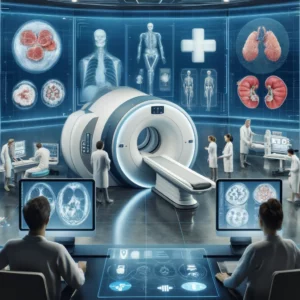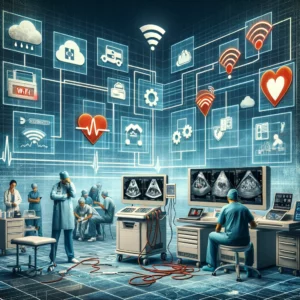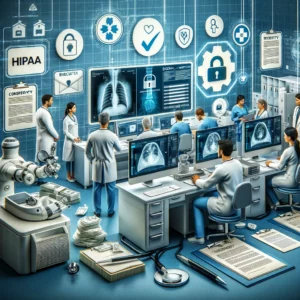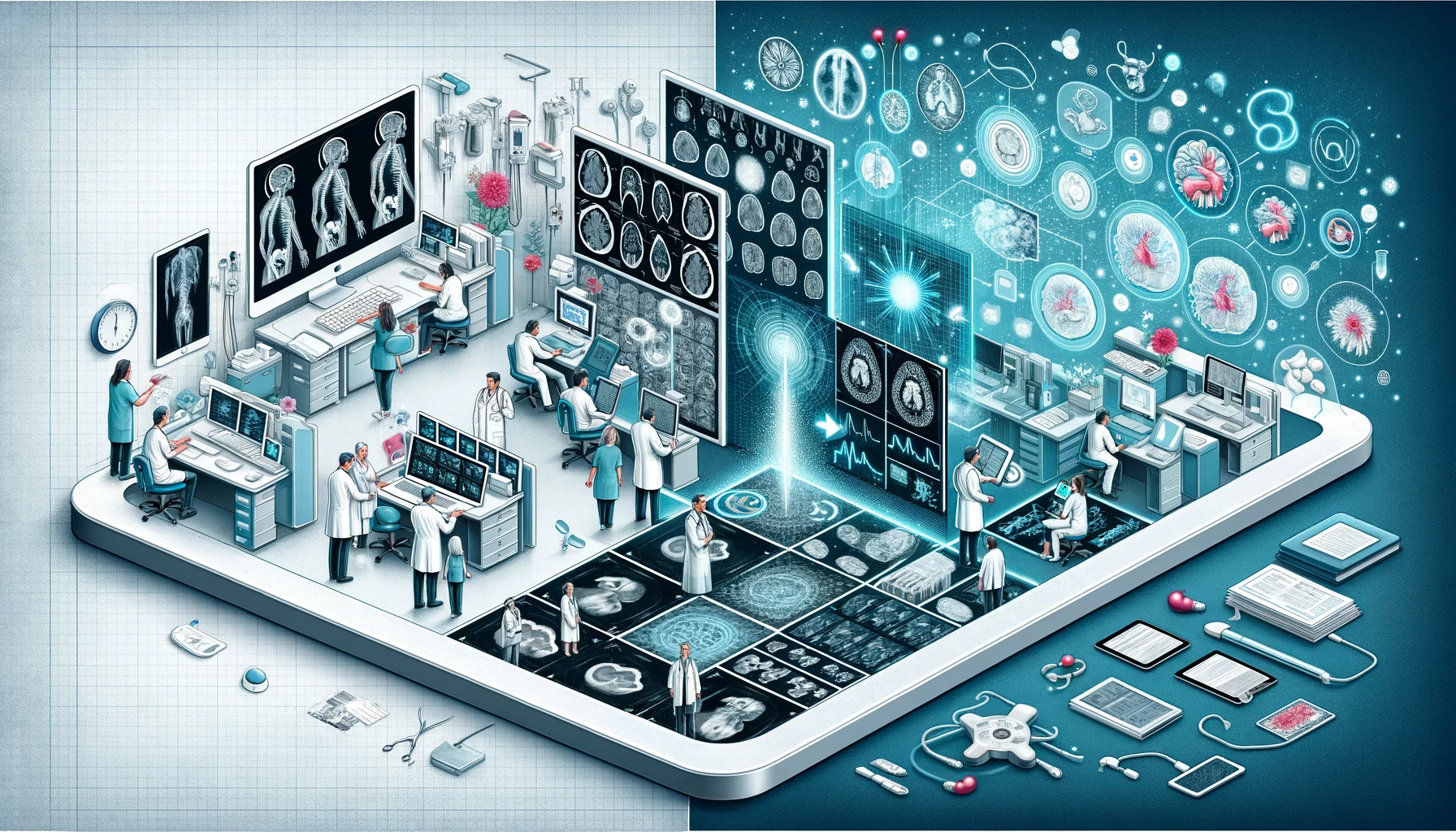The Rise of Digital Medical Imaging
The rise of digital medical imaging represents a revolutionary advancement in the field of healthcare, offering unprecedented capabilities for clinical analysis and medical intervention. Medical digital imaging involves the creation of visual representations of the interior of a body, allowing doctors and specialists to see inside the human body without invasive procedures. This technology plays a critical role in diagnosing and treating various conditions, ranging from broken bones and tumors to cardiovascular diseases and neurological disorders. By providing clear and detailed images, it aids in the accurate diagnosis, effective treatment planning, and monitoring of patient progress.
Digital medical imaging utilizes advanced digital processing techniques to generate images of body structures and organs. Unlike traditional film-based imaging, digital methods convert the captured data into electronic signals that are then processed by computers to create high-resolution images. This digital approach enhances the clarity and detail of the images, making it easier for healthcare professionals to identify abnormalities and make precise diagnoses. Moreover, digital images can be easily stored, retrieved, and shared across different healthcare facilities, promoting better collaboration and continuity of care.

Radiography, one of the most common forms of digital medical imaging, involves the use of X-rays to create digital images of the body’s internal structures. This technique is particularly effective in identifying bone fractures, infections, and abnormalities. Radiographs, or X-ray images, are produced by passing X-rays through the body, with denser structures like bones absorbing more X-rays and appearing white on the image, while less dense tissues appear in shades of gray. This contrast allows for clear visualization of skeletal injuries and conditions, making radiography an indispensable tool in emergency and diagnostic medicine.
Computed Tomography (CT) takes radiography a step further by using computer-processed combinations of many X-ray measurements taken from different angles to produce cross-sectional images, or slices, of specific areas of the body. These slices can then be compiled to create a detailed three-dimensional image. CT scans are invaluable for diagnosing a wide range of conditions because they provide a more comprehensive view of internal organs, bones, soft tissues, and blood vessels. This modality is particularly useful in detecting tumors, internal bleeding, and other critical conditions that may not be visible with traditional X-ray imaging.
Magnetic Resonance Imaging (MRI) uses a powerful magnetic field and radio waves to generate detailed images of the organs and tissues within the body. Unlike X-rays and CT scans, MRI does not use ionizing radiation, making it a safer option for repeated imaging, especially for sensitive areas like the brain and spinal cord. MRI is particularly effective in imaging soft tissues, such as the brain, muscles, and ligaments, providing high-resolution images that help in diagnosing conditions like tumors, strokes, and musculoskeletal disorders. The ability to differentiate between various types of soft tissue makes MRI an essential tool in many medical specialties.
Ultrasound imaging employs high-frequency sound waves to produce images of the inside of the body. This modality is widely used in prenatal care to monitor the development of a fetus, as it is safe and non-invasive. Ultrasound is also used to examine other parts of the body, including the heart, blood vessels, kidneys, and liver, making it versatile in diagnosing a variety of conditions. In addition to these, Positron Emission Tomography (PET) scans use a radioactive substance to detect disease within the body by providing detailed information about the function and metabolism of organs. Digital mammography, another crucial imaging technique, uses low-dose X-rays for the early detection of breast cancer, significantly improving the chances of successful treatment. The rise of these digital imaging modalities has revolutionized healthcare, enabling more accurate, faster, and efficient diagnosis and treatment of various diseases, offering insights into the human body that traditional methods could never achieve.
Advantages of Digital Medical Imaging

Digital medical imaging offers the advantage of instant viewing and easy sharing of images among healthcare providers, significantly reducing the time required to deliver and review patient images. Unlike traditional film-based methods that necessitate physical transportation of films, digital images can be transmitted electronically, allowing multiple healthcare professionals to access the same image simultaneously from different locations. This rapid access facilitates quicker consultations, second opinions, and collaborative decision-making, which are essential in emergency situations where time is critical. Consequently, the speed at which digital images can be reviewed enhances the overall efficiency of the diagnostic process and expedites the initiation of treatment.
Moreover, the ability to easily share digital images across various healthcare settings fosters a more integrated approach to patient care. Specialists in different fields can promptly review and discuss imaging results, leading to more comprehensive and coordinated treatment plans. This seamless exchange of information also supports telemedicine, enabling remote consultations and access to expert opinions regardless of geographic barriers. By streamlining the workflow and improving communication among healthcare providers, the faster access and sharing of digital medical images contribute to more timely and effective patient care, ultimately improving clinical outcomes and patient satisfaction.
Digital medical imaging offers a significant advantage in terms of reduced storage space requirements, as images are stored electronically rather than on physical film. This transition to digital storage eliminates the need for large, cumbersome storage facilities, thereby reducing associated costs such as maintenance and space rental. Additionally, managing patient records becomes much simpler and more efficient with digital storage. Electronic health records can be organized, accessed, and retrieved quickly, ensuring that patient information is readily available when needed. This streamlined approach to record-keeping not only enhances operational efficiency within healthcare facilities but also improves the accuracy and reliability of patient data management.
The ease of sharing and discussing digital medical images significantly enhances collaboration among healthcare providers. By enabling quick and efficient access to high-quality images, digital imaging allows specialists from various fields to work together more effectively, regardless of their physical locations. This seamless exchange of information fosters better communication, ensuring that all team members are informed and aligned on the patient’s condition and treatment plan. Such coordinated care improves diagnostic accuracy, expedites treatment decisions, and enhances the overall quality of patient care. As a result, patients benefit from a more comprehensive and cohesive approach to their healthcare, leading to better outcomes and increased satisfaction.
Impact of Digital Imaging on Medical Record Retrieval
Enhanced Speed and Efficiency
Digital imaging in medical record retrieval revolutionizes the way patient records are accessed, enabling quick and efficient retrieval of essential medical information. Unlike the traditional method of sifting through physical files, which can be time-consuming and prone to errors, digital records are organized and stored in a centralized system that can be accessed with a few clicks. This rapid access to patient history, previous imaging, and other critical data ensures that healthcare providers can make informed decisions promptly. The elimination of time spent searching for physical files significantly improves the workflow within medical facilities, allowing healthcare professionals to focus more on patient care and less on administrative tasks.
The enhanced speed and efficiency provided by digital imaging also translate into improved medical services overall. Quick access to comprehensive patient records means that diagnostic procedures, consultations, and treatment plans can be initiated without unnecessary delays. This is particularly beneficial in emergency situations where every second counts. Additionally, streamlined digital processes reduce the likelihood of misplaced or lost records, ensuring that patient information is always available and up-to-date. This efficiency not only enhances the quality of care but also increases patient satisfaction, as individuals experience shorter wait times and more prompt medical attention. By integrating digital imaging into medical record retrieval, healthcare systems can operate more smoothly and effectively, ultimately leading to better patient outcomes.
Improved Accuracy

Ensuring the accuracy of medical records through digital imaging is crucial for making correct diagnoses and developing effective treatment plans. Accurate and comprehensive records allow healthcare providers to have a clear understanding of a patient’s medical history, current conditions, and previous treatments. This detailed information is vital for diagnosing illnesses accurately and determining the most appropriate course of action. Furthermore, precise records help in monitoring the progress of treatments and making necessary adjustments. Overall, the improved accuracy facilitated by digital imaging not only enhances the quality of care provided to patients but also supports better health outcomes and increases patient safety.
Increased Accessibility
Digital images of medical records can be accessed from any location, greatly enhancing the accessibility of crucial medical information. This capability is particularly beneficial for remote consultations and treatments, allowing healthcare providers to review patient records and images even when they are not physically present in the same location. Telemedicine, which has become increasingly important, relies heavily on this digital accessibility, enabling specialists to provide expert opinions and guidance to patients in underserved or remote areas. This widespread access ensures that high-quality medical care is not limited by geographical constraints, thus expanding the reach of healthcare services.
In emergency situations, the ability to access digital medical records instantly is invaluable. Immediate access to a patient’s history, including past imaging, diagnoses, and treatment plans, can significantly influence the speed and accuracy of emergency care decisions. For instance, emergency responders and doctors can quickly review critical information, such as allergies, pre-existing conditions, and prior treatments, which are essential for making informed decisions under pressure. This rapid access can be the difference between life and death, ensuring that patients receive timely and appropriate care. The increased accessibility provided by digital imaging thus not only enhances routine medical care but also plays a crucial role in improving outcomes in critical situations.
Enhanced Storage and Space Saving
Digitalization of medical records frees up considerable physical space that would otherwise be dedicated to storing paper files. In traditional healthcare settings, vast areas are often allocated for the storage of patient records, X-ray films, and other documents. By transitioning to digital records, healthcare facilities can repurpose these spaces for more productive uses, such as additional treatment rooms, advanced medical equipment, or patient amenities. This shift not only optimizes the use of physical space but also aligns with modern, streamlined facility designs that emphasize efficiency and accessibility.
Moreover, the transition to digital storage significantly reduces the costs associated with physical storage and maintenance. Maintaining physical records involves ongoing expenses such as purchasing storage supplies, renting or maintaining storage facilities, and employing staff to manage and organize the files. Digital storage, in contrast, requires less physical infrastructure and can be managed more efficiently with automated systems. Additionally, digital records are easier to back up and protect against damage or loss, further enhancing the cost-effectiveness and reliability of record-keeping. Overall, enhanced storage and space-saving through digitalization not only improve operational efficiency but also provide economic benefits to healthcare organizations.
Facilitates Collaboration
Digital imaging greatly facilitates collaboration by enabling the easy sharing of medical records among healthcare professionals. With digital systems, medical images and patient records can be transmitted securely and instantly across various platforms and devices. This capability allows doctors, specialists, and other healthcare providers to access the same information simultaneously, regardless of their location. The ease of sharing detailed and high-resolution images means that specialists can view the same scans, provide input, and collaborate in real-time, leading to more comprehensive and cohesive patient care.
This enhanced ability to share and review medical records is particularly beneficial in cases where multiple specialists are involved in a patient’s care. For example, a patient with a complex condition may require the expertise of a radiologist, a surgeon, and a primary care physician. With digital imaging, these professionals can quickly share their findings and recommendations, ensuring that everyone has the most up-to-date and accurate information. This seamless collaboration helps in developing more effective treatment plans, reduces the likelihood of miscommunication, and ensures that all aspects of a patient’s health are considered. Ultimately, the facilitation of collaboration through digital imaging leads to more informed decision-making and better patient outcomes.
Promotes Patient Privacy
Digital medical records are often encrypted, providing a high level of security that ensures patient privacy and compliance with regulations like the Health Insurance Portability and Accountability Act (HIPAA). Encryption protects sensitive patient information from unauthorized access during storage and transmission, safeguarding against data breaches and cyber threats. Secure digital systems also allow for controlled access, where only authorized personnel can view or modify medical records. This robust security framework promotes patient trust and ensures that healthcare providers meet legal and ethical standards for privacy and confidentiality in handling medical information.
Enables Better Patient Care
Quick and easy access to accurate, comprehensive patient records significantly enhances the ability of healthcare providers to deliver personalized and efficient care. Digital records consolidate all pertinent information about a patient’s medical history, current conditions, treatments, and medications, making it readily available at the point of care. This comprehensive overview allows healthcare professionals to make informed decisions swiftly, tailor treatments to individual needs, and monitor progress more effectively. The ability to quickly retrieve and review detailed patient data ensures that care is both timely and precise, reducing the likelihood of errors and improving overall patient outcomes. By enabling better coordination and continuity of care, digital medical records play a crucial role in advancing the quality and effectiveness of healthcare services.
Disaster Recovery

The ability to swiftly restore digital records ensures continuity of care and minimizes disruptions in healthcare services. In emergency situations, having immediate access to accurate and complete patient records is essential for providing appropriate and timely care. Digital backups allow healthcare facilities to resume operations with minimal delay, ensuring that patient treatment plans, medical histories, and ongoing care are not interrupted. This resilience not only protects the healthcare infrastructure but also enhances patient trust and safety, knowing that their medical information is secure and available even in the face of disasters. Ultimately, the disaster recovery capabilities of digital medical imaging strengthen the overall reliability and robustness of healthcare systems.
Online Access to Images through Secure Portals
Digital imaging enables personal injury attorneys to access medical records remotely through secure online portals, greatly simplifying the retrieval process. These portals are designed with robust security measures, ensuring that sensitive patient information is protected while being accessible to authorized users. Attorneys can conveniently review medical images and records from any location, facilitating the preparation of legal cases without the need for physical documents. This remote access not only streamlines the workflow for legal professionals but also speeds up the process of gathering necessary evidence, ultimately aiding in the timely resolution of personal injury claims. By leveraging digital imaging and secure online portals, attorneys can efficiently manage and utilize medical records, enhancing their ability to advocate effectively for their clients.
Faster Turnaround Times
Digital imaging eliminates the need for physical films, significantly reducing the time it takes for attorneys to retrieve medical records. Traditional methods often involve lengthy processes of requesting, shipping, and handling physical films, which can delay legal proceedings. In contrast, digital records can be accessed almost instantaneously through electronic systems, allowing attorneys to obtain the necessary medical images and documentation promptly. This swift retrieval process is especially beneficial in legal cases where time is of the essence, enabling attorneys to review and analyze medical evidence quickly and efficiently. By facilitating faster turnaround times, digital imaging enhances the overall efficiency of legal workflows, ensuring that cases progress smoothly and without unnecessary delays. This timely access to medical records not only benefits legal professionals but also supports a more effective and responsive legal system.
Improved Accuracy and Completeness
Digital imaging ensures more accurate and complete medical records by allowing for easy searching, filtering, and cross-referencing of data. Unlike traditional paper-based records, digital images and documents are stored in organized databases that enable quick and precise retrieval of specific information. This ability to search and filter through vast amounts of medical data reduces the risk of missing crucial details, ensuring that healthcare providers have access to comprehensive patient information. Additionally, digital records can be cross-referenced with other medical data, such as lab results and medication histories, providing a holistic view of the patient’s health.
The enhanced accuracy and completeness offered by digital imaging improve diagnostic precision and treatment planning. Healthcare providers can easily verify and update patient information, reducing the likelihood of errors that could arise from manual entry or interpretation of handwritten notes. This level of detail and integration supports more informed decision-making, leading to better patient outcomes. Overall, the transition to digital imaging fosters a more reliable and efficient healthcare system, where accurate and complete medical records are readily available to those who need them.
Potential Challenges of Using Digital Medical Imaging on Medical Record Retrieval
Digital medical imaging relies heavily on advanced technologies, which introduces the potential for technical deficiencies. Issues such as software glitches, hardware failures, or network outages can impede the retrieval of patient records, disrupting the flow of medical information and potentially delaying care. For instance, if a server crashes or a software update malfunctions, healthcare providers might find themselves unable to access critical imaging data when they need it most. These technical interruptions can be particularly problematic in emergency situations where timely access to patient information is crucial for decision-making.
To mitigate these risks, robust IT infrastructure and comprehensive backup systems are essential. Regular maintenance, updates, and contingency plans must be in place to ensure that any technical issues can be swiftly addressed. Additionally, training healthcare staff to handle such technical challenges and having a reliable support team on standby can help minimize the impact of these deficiencies. Despite these precautions, the reliance on digital technology inherently carries a risk of technical problems, underscoring the importance of continual investment in technology and support systems to maintain the reliability of digital medical imaging.
High Implementation Cost
Setting up digital medical imaging systems involves substantial initial costs, which can be a significant barrier for many healthcare facilities. The expenses include purchasing advanced imaging equipment, installing robust IT infrastructure, acquiring specialized software, and training staff to use and maintain these systems. Additionally, ongoing costs such as system upgrades, maintenance, and cybersecurity measures further add to the financial burden. For large, well-funded hospitals, these costs might be manageable, but for smaller clinics, especially those in rural areas or developing countries, the investment required for digital medical imaging can be prohibitively expensive.
The high implementation cost of digital medical imaging technology affects the ability of these facilities to retrieve and utilize medical records efficiently. Without access to digital systems, healthcare providers in underserved regions may have to rely on outdated and less efficient methods, which can compromise the quality and speed of patient care. This disparity in access to advanced medical imaging technology can exacerbate existing healthcare inequalities, leaving patients in these areas with limited diagnostic and treatment options. Addressing these financial barriers through funding initiatives, grants, and technology partnerships is crucial to ensure that all healthcare facilities, regardless of their location or resources, can benefit from the advancements in digital medical imaging.
Data Storage Issues
Storing high-resolution images generated by digital medical imaging systems requires substantial storage space, posing a significant challenge for healthcare facilities. High-quality images, essential for accurate diagnosis and treatment planning, can consume large amounts of digital storage, quickly filling up available space. This is particularly problematic for facilities with limited IT infrastructure or budget constraints, where expanding storage capacity may not be feasible.
Limited storage can hinder the efficient retrieval of medical records, as systems may become slow or overloaded, affecting the speed and reliability of accessing patient data. Additionally, the need for robust data management solutions to handle the vast amount of information adds to the complexity and cost. Without adequate storage, healthcare providers may struggle to maintain comprehensive and easily accessible patient records, potentially compromising the quality of care. To address these issues, investing in scalable storage solutions, such as cloud-based services, and implementing efficient data management practices are essential to ensure that medical records remain readily available and secure.
Dependency on Internet Connectivity

This dependency on internet connectivity can be particularly problematic in rural or underserved areas where high-speed internet infrastructure may be lacking. Interruptions or slow connections not only delay the retrieval process but can also disrupt the continuity of care, affecting the overall quality of healthcare services. Additionally, in emergency situations where quick access to patient records is critical, any delay caused by internet issues can have serious implications for patient outcomes. To mitigate these challenges, healthcare providers must invest in reliable internet solutions and backup systems to ensure continuous access to digital medical images, regardless of connectivity issues.
Security and Privacy Concerns
Digital medical imaging systems, while offering numerous advantages, are inherently vulnerable to cyberattacks and data breaches, which pose significant security and privacy concerns. Hackers and malicious actors often target healthcare data due to its sensitive nature and high value. A successful cyberattack can result in unauthorized access to patient records, including medical images, personal identification information, and treatment histories. Such breaches can have severe consequences, including identity theft, financial fraud, and compromised patient confidentiality.
Ensuring the security and privacy of digital medical records requires robust cybersecurity measures, including encryption, firewalls, regular software updates, and comprehensive access controls. Healthcare facilities must also adhere to stringent regulatory frameworks, such as the Health Insurance Portability and Accountability Act (HIPAA), to protect patient information. Despite these efforts, the evolving nature of cyber threats means that even well-protected systems are at risk. Therefore, continuous monitoring, regular security audits, and staff training on data protection protocols are essential to safeguarding digital medical imaging systems against potential cyber threats, ensuring that patient privacy is maintained.
Complexities in Integration
Integrating digital imaging with existing health records systems presents significant complexities that can challenge healthcare providers. These systems often involve different software platforms, data formats, and operational protocols, making seamless integration difficult. The complexity arises from the need to ensure that all systems communicate effectively and that data flows smoothly between them. Incompatibilities or misconfigurations during the integration process can lead to fragmented data, errors, and inefficiencies, complicating the retrieval and use of medical records.
Any missteps in this integration can severely impact the efficiency of accessing patient information. For instance, if digital imaging data does not sync properly with electronic health records (EHR), healthcare providers may face delays in retrieving comprehensive patient histories, leading to potential diagnostic and treatment errors. These issues can disrupt the continuity of care and reduce the overall quality of healthcare services. To mitigate these risks, thorough planning, robust testing, and collaboration with IT professionals are crucial. Ensuring that all systems are compatible and fully integrated helps streamline the retrieval process, enhancing the reliability and effectiveness of digital medical imaging in patient care.
Legal and Regulatory Compliance

Furthermore, noncompliance can restrict access to and retrieval of medical records, disrupting the continuity of patient care. Healthcare facilities may face operational challenges if their digital imaging systems do not meet regulatory requirements, potentially leading to system shutdowns or limited functionality imposed by oversight bodies. This can delay diagnoses and treatments, negatively impacting patient outcomes. Therefore, healthcare providers must ensure that their digital imaging systems are fully compliant with all relevant laws and regulations, regularly updating their protocols and technologies to keep pace with evolving standards. This commitment to legal and regulatory compliance not only protects patient information but also ensures the smooth and efficient operation of medical imaging services.
Steps to Start Utilizing Digital Imaging for Medical Record Retrieval
Acquire Necessary Equipment
Investing in high-quality scanning and imaging equipment is essential for capturing clear, detailed images of medical records. The precision and clarity provided by advanced imaging technology are crucial for accurate diagnosis and effective treatment planning. High-resolution scanners and imaging devices ensure that every detail of the medical records is captured accurately, reducing the likelihood of errors and misinterpretations. These detailed images allow healthcare providers to examine minute structures and abnormalities, leading to more precise and reliable medical assessments.
Additionally, high-quality equipment enhances the efficiency of the imaging process, enabling faster scanning and processing times. This not only improves the workflow within healthcare facilities but also allows for quicker access to vital patient information. Investing in the best available technology also future-proofs the facility, ensuring that it remains capable of meeting the demands of evolving medical practices and standards. Ultimately, prioritizing high-quality scanning and imaging equipment is a critical step in providing top-tier medical care, as it directly impacts the accuracy, speed, and reliability of medical record management and diagnostics.
Implement Proper Digital Imaging Software
Selecting and implementing proper digital imaging software is a crucial step in managing digital images of medical records effectively. This specialized software enables healthcare providers to upload, store, and organize vast amounts of digital images systematically, ensuring that they are easily accessible when needed. The right software solution will offer user-friendly interfaces, robust storage capabilities, and advanced search functionalities, allowing medical professionals to quickly locate and retrieve specific images and records.
Moreover, digital imaging software often includes features such as image enhancement, annotation tools, and integration with electronic health record (EHR) systems. These functionalities enhance the clarity of images, enable detailed notes to be added directly to the images, and ensure seamless incorporation into the broader patient record system. By implementing such software, healthcare facilities can streamline their imaging processes, reduce the risk of data loss, and improve overall efficiency in handling patient records. Choosing a software solution that aligns with the facility’s needs and workflows is essential for maximizing the benefits of digital imaging technology, ultimately contributing to better patient care and operational effectiveness.
Train Staff
Providing comprehensive training for staff on how to use digital imaging equipment and software is essential to ensure the accurate and efficient conversion of paper records into digital images. Training programs should cover the fundamental operations of scanning and imaging devices, including how to handle different types of documents and optimize image quality. Staff should also be instructed on how to use the digital imaging software to upload, store, organize, and retrieve medical records effectively. This training will help them become proficient in utilizing the tools at their disposal, reducing the risk of errors and improving the overall workflow.
Effective training also emphasizes the importance of following standard operating procedures and best practices for digital imaging. Staff should be educated on data security measures, such as proper handling of patient information and compliance with regulations like HIPAA. Additionally, ongoing training and support should be available to keep staff updated on new features or updates to the software and equipment. By investing in thorough training programs, healthcare facilities can ensure that their staff is well-equipped to manage digital medical records, enhancing the accuracy, efficiency, and security of their record-keeping processes. This not only improves operational efficiency but also contributes to better patient care by ensuring that medical records are accurately digitized and readily accessible.
Establish a Scanning Schedule
Establishing a scanning schedule is vital for the systematic and efficient digitization of medical records. A well-defined schedule ensures that all paper records are converted into digital format in a timely and organized manner. This process involves prioritizing documents based on their urgency and relevance, such as current patient files and frequently accessed records. By creating a consistent scanning routine, healthcare facilities can prevent backlogs and ensure that new records are promptly digitized, maintaining up-to-date and easily accessible patient information.
A structured scanning schedule also helps in managing workload and resource allocation. Assigning specific days or times for scanning tasks allows staff to balance their duties effectively without disrupting other critical operations. Regularly scheduled scanning sessions ensure that the digitization process becomes an integral part of the facility’s workflow. Additionally, periodic reviews of the scanning schedule can help identify inefficiencies and areas for improvement, allowing for adjustments to enhance productivity. Establishing and adhering to a scanning schedule ultimately contributes to a seamless transition to digital record-keeping, improving the accuracy, accessibility, and reliability of medical records management.
Set Up a Quality Control Process
Setting up a quality control process is essential to ensure the clarity and accuracy of scanned images in digital medical imaging. Implementing a robust quality control protocol involves systematically reviewing a sample of scanned documents to verify that the images are clear, legible, and accurately reflect the original paper records. This process helps identify any issues such as blurry images, incomplete scans, or misaligned documents, allowing for immediate corrective actions before the images are stored in the digital system.
A quality control process should include standardized checklists and criteria for evaluating the quality of scanned images. Trained staff should be responsible for conducting these reviews, ensuring that each scanned image meets the required standards. Additionally, incorporating feedback mechanisms allows for continuous improvement, where common issues can be addressed, and best practices can be reinforced. Regular audits and reviews of the quality control process itself are also important to adapt to any changes in technology or procedures. By maintaining a stringent quality control process, healthcare facilities can prevent errors, ensure the integrity of digital medical records, and provide reliable and accurate information for patient care and clinical decision-making.
Ensure Compliance with Regulations
Ensuring compliance with regulations is a critical aspect of implementing digital imaging processes in healthcare settings. This involves adhering to all relevant medical and data privacy regulations to protect patient information and maintain the integrity of medical records. In the United States, this includes compliance with the Health Insurance Portability and Accountability Act (HIPAA), which sets stringent standards for the protection of health information. HIPAA requires healthcare providers to implement robust security measures, such as encryption, access controls, and audit trails, to safeguard electronic health records and digital images from unauthorized access and breaches.
Compliance also entails regularly updating and reviewing policies and procedures to align with current regulations and best practices. This includes conducting periodic risk assessments to identify potential vulnerabilities and implementing appropriate safeguards to mitigate those risks. Training staff on regulatory requirements and the importance of data privacy is essential to ensure that everyone involved in the digital imaging process understands their responsibilities and adheres to compliance protocols. By establishing a comprehensive compliance framework, healthcare facilities can protect patient privacy, avoid legal penalties, and build trust with patients, ensuring that their digital imaging processes support both high-quality care and regulatory standards.
Develop a Backup and Recovery Plan
Developing a backup and recovery plan is essential to safeguard digital images of medical records from potential system failures or data loss. This plan should outline strategies for regularly backing up data to secure, off-site locations, such as cloud storage or dedicated backup servers. By ensuring that multiple copies of digital images are stored in different locations, healthcare facilities can protect against data loss due to hardware malfunctions, cyberattacks, or natural disasters.
A comprehensive backup and recovery plan should include detailed procedures for how backups will be performed, specifying the frequency and type of backups (full, incremental, or differential). Regularly scheduled backups, ideally automated, ensure that the most recent data is consistently captured and stored securely. Additionally, the plan must define clear protocols for restoring data quickly and efficiently in case of an emergency. This involves training staff on recovery procedures and conducting regular drills to test the effectiveness of the plan, ensuring that all team members are prepared to respond promptly to data loss incidents.
By implementing a robust backup and recovery plan, healthcare facilities can minimize downtime, maintain continuity of care, and protect the integrity of their medical records. This proactive approach not only safeguards critical patient information but also helps maintain trust and compliance with legal and regulatory requirements, ensuring that healthcare providers can continue to deliver high-quality care even in the face of unexpected challenges.
Regularly Update and Maintain the System
Regularly updating software and maintaining equipment are essential practices to ensure the continued effectiveness of digital imaging systems. Software updates often include important security patches, performance enhancements, and new features that can improve functionality and protect against emerging threats. Keeping your digital imaging software up-to-date helps to prevent vulnerabilities that could be exploited by cyberattacks, ensuring the security and integrity of medical records. Similarly, routine maintenance of imaging equipment, such as scanners and servers, ensures they operate at optimal performance, reducing the risk of hardware failures that could disrupt the digitization process.
In addition to technical updates and maintenance, it is important to periodically review and refine your procedures to maintain efficiency and compliance with evolving regulations. This involves assessing current workflows, identifying bottlenecks or inefficiencies, and implementing process improvements as needed. Regular audits and reviews also help ensure that practices remain aligned with legal and regulatory requirements, such as HIPAA, and that any changes in these regulations are promptly incorporated into your procedures. By continuously updating and maintaining both the technical and procedural aspects of your digital imaging system, you can ensure its reliability, security, and compliance, ultimately supporting high-quality patient care and streamlined operations.
Consult a Medical Digital Imaging Service Provider
Consulting a medical digital imaging service provider is a valuable step for healthcare facilities looking to enhance their use of digital imaging technology in diagnostics and treatment. A professional provider can offer comprehensive insights into the latest advancements in imaging technologies such as MRI, CT scans, and X-rays, explaining how these have been digitized to facilitate easy storage, retrieval, and sharing of medical images. This consultation can help healthcare administrators and practitioners understand the benefits of transitioning to digital systems, including the improved accuracy and efficiency in managing patient records.
The service provider can demonstrate the practical applications of digital imaging, showcasing how these technologies have transformed the retrieval and analysis of medical records. By enabling remote viewing and diagnosis, digital imaging allows doctors to access patient images from any location, fostering quicker and more accurate clinical decisions. This capability is particularly beneficial in telemedicine and multidisciplinary consultations, where timely access to high-quality images is crucial. Through such consultations, healthcare providers can gain a clear understanding of how digital imaging enhances patient care by streamlining workflows, reducing delays in diagnosis, and facilitating better collaboration among medical professionals. This knowledge empowers healthcare facilities to make informed decisions about implementing and optimizing digital imaging solutions in their practice.










